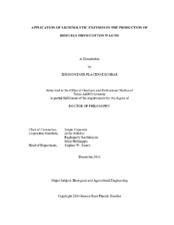| dc.contributor.advisor | Capareda, Sergio | |
| dc.creator | Placido Escobar, Jersson Emir | |
| dc.date.accessioned | 2015-04-28T15:34:40Z | |
| dc.date.available | 2016-12-01T06:36:07Z | |
| dc.date.created | 2014-12 | |
| dc.date.issued | 2014-12-02 | |
| dc.date.submitted | December 2014 | |
| dc.identifier.uri | https://hdl.handle.net/1969.1/154082 | |
| dc.description.abstract | The application of ligninolytic fungi and enzymes is an option to overcome the issues related with the production of biofuels using cotton wastes. In this dissertation, the ligninolytic fungus and enzymes were evaluated as pretreatment for the biochemical conversion of Cotton Gin Trash (CGT) in ethanol and as a treatment for the transformation of cotton wastes biochar in other substances.
In biochemical conversion, seven combinations of three pretreatments (ultrasonication, liquid hot water and ligninolytic enzymes) were evaluated on CGT. The best results were achieved by the sequential combination of ultrasonication, hot water, and ligninolytic enzymes with an improvement of 10% in ethanol yield. To improve these results, alkaline-ultrasonication was evaluated. Additionally, Fourier Transform Infrared (FT-IR) and principal component analysis (PCA) were employed as fast methodology to identify structural differences in the biomass. The combination of ultrasonication-alkali hydrolysis, hot liquid water, and ligninolytic enzymes using 15% of NaOH improved 35% ethanol yield compared with the original treatment. Additionally, FT-IR and PCA identified modifications in the biomass structure after different types of pretreatments and conditions.
In thermal conversion, this study evaluated the biodepolymerization of cotton wastes biochar using chemical and biological treatments. The chemical depolymerization evaluated three chemical agents (KMnO4, H2SO4, and NaOH), with three concentrations and two environmental conditions. The sulfuric acid treatments performed the largest transformations of the biochar solid phase; whereas, the KMnO4 treatments achieved the largest depolymerizations. The compounds released into the liquid phase were correlated with fulvic and humic acids and silicon compounds.
The biological depolymerization utilized four ligninolytic fungi Phanerochaete chrysosporium, Ceriporiopsis subvermispora, Postia placenta, and Bjerkandera adusta. The greatest depolymerization was obtained by C. subvermispora. The depolymerization kinetics of C. subvermispora evidenced the production of laccase and manganese peroxidase and a correlation between depolymerization and production of ligninolytic enzymes. The modifications obtained in the liquid and solid phases showed the production of humic and fulvic acids from the cultures with C. subvermispora.
The results of this research are the initial steps for the development of new processes using the ligninolytic fungus and their enzymes for the production of biofuels from cotton wastes. | en |
| dc.format.mimetype | application/pdf | |
| dc.language.iso | en | |
| dc.subject | Ligninolytic Fungi | en |
| dc.subject | Laccase | en |
| dc.subject | Cotton Wastes, Biochar | en |
| dc.subject | Ethanol, Depolymerization | en |
| dc.subject | Pretreatments, | en |
| dc.title | Application of Ligninolytic Enzymes in the Production of Biofuels from Cotton Wastes | en |
| dc.type | Thesis | en |
| thesis.degree.department | Biological and Agricultural Engineering | en |
| thesis.degree.discipline | Biological and Agricultural Engineering | en |
| thesis.degree.grantor | Texas A & M University | en |
| thesis.degree.name | Doctor of Philosophy | en |
| thesis.degree.level | Doctoral | en |
| dc.contributor.committeeMember | Nikolov, Zivko | |
| dc.contributor.committeeMember | Karthikeyan, Raghuparty | |
| dc.contributor.committeeMember | Holtzapple, Mark | |
| dc.type.material | text | en |
| dc.date.updated | 2015-04-28T15:34:40Z | |
| local.embargo.terms | 2016-12-01 | |
| local.etdauthor.orcid | 0000-0003-0385-8777 | |


